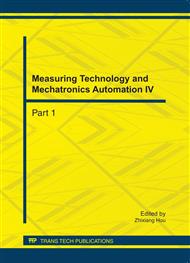[1]
Bakar M I A. Assessments for the impact of harmonic current distortion of non linear load in power system harmonics[C]. in Transmission and Distribution Conference and Exposition: Latin America, 2008 IEEE/PES, 2008, pp.1-6.
DOI: 10.1109/tdc-la.2008.4641724
Google Scholar
[2]
Chang G W. Characterizing harmonic currents generated by fluorescent lamps in harmonic domain[J]. IEEE Transactions on Power Delivery, 2003, 18(4): 1583-1585.
DOI: 10.1109/tpwrd.2003.817519
Google Scholar
[3]
Dugan R C, Santoso S, McGranaghan M F, et al. Electrical Power Systems Quality[M]. McGraw-Hill, New York, (1996).
Google Scholar
[4]
Johnson J R. Managing harmonics and resonance with active harmonic filters in an offshore ring main oil field[C]. in Harmonics and Quality of Power, 2008. ICHQP 2008. 13th International Conference on, 2008, pp.1-8.
DOI: 10.1109/ichqp.2008.4668749
Google Scholar
[5]
Huang Z Y, Xu W and Dinavahi V R. A Practical Harmonic Resonance Guideline for Shunt Capacitor Applications[J]. IEEE Transaction on Power Delivery, 2003, 18(4): 1382-1387.
DOI: 10.1109/tpwrd.2003.817726
Google Scholar
[6]
Gao B, Morison G K and Kundur P. Voltage Stability Evaluation Using Modal Analysis[J]. IEEE Transaction on Power Systems, 1992, 7(4): 1529-1542.
DOI: 10.1109/59.207377
Google Scholar
[7]
Xu Wenyuan, Zhang Dahai. A modal analysis method for harmonic resonance assessment[J]. Proceedings of the CSEE, 2005, 25(22): 89-93. (in Chinese).
Google Scholar
[8]
Xu W, Huang Z, Cui Y, et al. Harmonic Resonance Mode Analysis, IEEE Transaction on Power Delivery, 2005, 20(2): 1182-1190.
DOI: 10.1109/tpwrd.2004.834856
Google Scholar
[9]
Yang Caixia, Liu Kaipei, Wang Dongxu. A Loop Modal Analysis Method for Series Harmonic Resonance Assessment[J]. High Voltage Engineering, 2008, 34(11): 2459-2462. (in Chinese).
DOI: 10.1109/icit.2008.4608385
Google Scholar
[10]
Gamm A Z, Golub I I, Bachry A. et al. Solving Several Problems of Power Systems Using Spectral and Singular Analyses[J]. IEEE Transaction on Power Systems, Feb, 2005, 20(1): 138-148.
DOI: 10.1109/tpwrs.2004.835658
Google Scholar
[11]
Gamm A Z , Golub I I. Application of Singular Analysis to Operating Reliability of Electric Power Systems[C]. In Proc. 1997 Int. Scientific Conf. APE, Jurata, Poland, pp: 193-201.
Google Scholar
[12]
Bellman R. Introduction to Matrix Analysis[M], 2nd ed. New York: McGraw-Hill, (1970).
Google Scholar
[13]
Huang Z, Cui Y, and Xu W. Application of Modal Sensitivity for Power System Harmonic Resonance Analysis[J]. IEEE Transaction on Power Systems, 2007, 22(2): 222-231.
DOI: 10.1109/tpwrs.2006.883678
Google Scholar
[14]
IEEE Recommended Practice and Requirements for Harmonic Control in Electric Power Systems[S], IEEE Std. 519-1993, IEEE, New York, (1993).
Google Scholar


